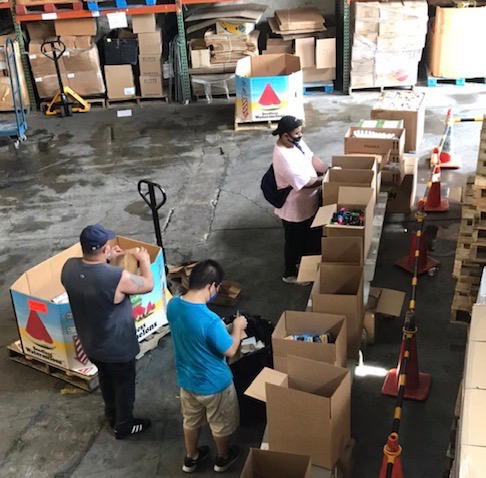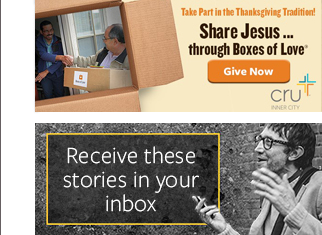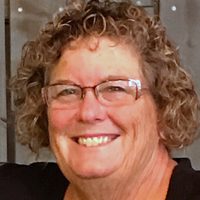
 Jayson Choe, a Cru® Inner City staff member in New York City, trekked to the grocery store. It was hot, typical for mid-July. An event poster plastered along the route captured his attention. His eyes locked on the mid-March date. As he scanned surrounding flyers he noticed they all had similar dates. Reality smacked him the face. Nothing was current.
Jayson Choe, a Cru® Inner City staff member in New York City, trekked to the grocery store. It was hot, typical for mid-July. An event poster plastered along the route captured his attention. His eyes locked on the mid-March date. As he scanned surrounding flyers he noticed they all had similar dates. Reality smacked him the face. Nothing was current.
Jayson was caught in a time warp. It was one of those moments where you are tempted to look around to see if you are being punked.
"It feels so strange to think that a few months ago the U.S. was in a pre-COVID mindset," he said. "It was like an alternate dimension."
The incident confirmed what Jayson had been feeling for months. The pandemic had isolated the community and interrupted valuable ministry opportunities in some of the Big Apple's poorest neighborhoods. The poverty — once overshadowed by Manhattan's neon lights — became much harder to neglect with a shuttered entertainment and tourism district.
For much of spring 2020, NYC was the nation's hotbed of coronavirus. By early July, job losses in the city were estimated at 1 million by The New York Times and, according to "No Cure in Sight," an August study conducted by The New School Center for New York City Affairs, the local unemployment rate in June — as measured by workers receiving unemployment benefits — was 32.7%. In the Bronx it was even higher, 41%.
These mind-numbing statistics represent actual families making difficult choices between food, rent, utilities and medications.
In terms of public assistance, there was a 16% increase in the number of residents filing for public assistance between February and June of last year. Food stamp enrollment also increased by 12.5% during the same time frame. The increase came at a time when the poverty rate in New York City was inching downward, according to an article on City Limits, which reported the poverty rate in the city dropped by 1.3 percent in 2019 to 16 percent. In 2014, it was 20.9%. Even with government subsidies, the poverty squeeze was getting tighter all the time.
As job losses and suffering mounted, churches continued seeking resources from Cru. Congregations with food pantries were seeing demand double and triple, while lines to receive the assistance wrapped around city blocks.
Unfortunately, Cru was not immune to the lockdown, which forced staff members to cancel upcoming events, including Easter Bags and other Compassionate Products™ distributions. Jayson, like his Cru colleagues, was feeling the weight of the crisis. Seeing the need among familiar faces, but being powerless to help due to social distancing, felt like wearing a Kevlar vest. It was needed for protection but was suffocating to wear and limited movement.
Not long after Jayson stumbled upon the long-expired event flyers, Cru Inner City was able to pivot by redirecting its Boxes of Love outreach to hosting a food distribution to benefit about 60 church partnerships. In all, the collaboration resulted in more than 20 tons of food gifted to 1,000 families in the five boroughs. Funding for the effort came through grants and emergency funds procured by Cru's local staff.
Within two weeks of receiving the funds, the Cru team, following mandated social-distancing requirements, distributed groceries through a drive-by event at its warehouse.
Until that outreach, Jayson said the pandemic left him feeling powerless and at times small. There was so much need but, because of the quarantine, there was no avenue to meet it.
Jayson recalled thinking, "I am working in a ministry, in a city that tries to serve and minister to people that are hurting — the most vulnerable and marginalized — but I can't do anything. We are in the ministry and we can't do anything right now. We're socially distancing, and I don't have anything to give out.
"It's not that I ever doubted that God was doing anything, but now I can be a part of what God is doing and that encourages me, versus just being a spectator."
He was finally able to get moving in that Kevlar vest.
Jayson, like many other Americans, admitted the stay-at-home order created a type of funk making it difficult to see beyond the moment or even the next day. But actively participating in what God was doing brought encouragement.
As a result, lives have been changed.
One local pastor used food from the Cru distribution to show Christlike kindness to the family of a man who died of COVID-19. As a result of receiving the food, the grieving mother and daughter became more receptive to the gospel. They began attending church and both put their faith in Jesus Christ.
"Being able to see the food distribution — and actively participating in it — kind of helped me think beyond surviving," Jayson said. "It's like, 'OK God, you're still moving, you're still doing great things.' It helped me see beyond just tomorrow."
That view inspired Jayson, who faced his own sorrow as partner churches began losing members to COVID-19 — among them a pastor he knew.
"It was jarring," he said of the pastor's passing.
The response to the coronavirus has been a mixed effort of juggling needs, ministering to people in the moment, and setting aside grief.
"I have a ministry that I still have to engage with or be fully present for," he said, admitting he pushed the pause button on his own grief to focus on community needs. "After the ministry was done, it was 'OK, now I do have time to un-pause and process.'"
The situation has given Jayson a new appreciation for the dedicated work of Cru's partner ministries, who diligently search out ways to keep serving their impoverished communities.
"They are still doing great ministry," he said. "They're still doing things in their neighborhood."

Previous Posts:
 Lori Arnold serves as senior writer for Cru's inner-city ministry.
Lori Arnold serves as senior writer for Cru's inner-city ministry.
©1994-2024 Cru. All Rights Reserved.